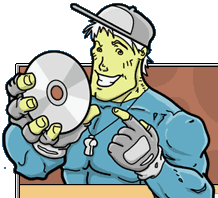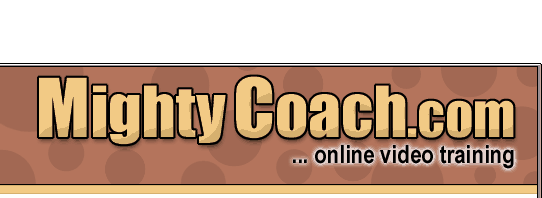
An alternative to burning DVDs ...
the VCD!
Last
updated 5-29-03
When people talk about burning movies on disk, you probably think of
DVDs. After all, the DVD format is very popular in the US and many over-hyped
computer commercials taut how easy it is to burn your movies onto a blank
DVD disk.
However, burning a DVD is not necessarily an easy or inexpensive endeavor.
While the price of computer DVD writers and blank disks are coming down
rapidly (and will soon be as ubiquitous as CD-writers), burning your own
DVD can be pricey. DVD writers cost about $300 and good DVD media still
costs over $4 (8 dollars in the store).
To further confuse the picture, DVD (as a recording format) has not yet
matured. There are several different disk formats (DVD-R, DVD+R, and DVD-RAM)
and each has variable compatibility with set-top DVD players. In addition,
every brand of blank DVD has different compatibility … a homemade
movie burned onto a Verbatim DVD-R may play on different DVD players than
the same movie burned on a Pioneer DVD-R.
Enter the
VCD
If you don’t want to spring for a DVD writer, there is a cheaper
alternative. Using your computer’s CD-writer you can burn your movie
onto a normal CD-R blank, and create a VCD, or “video cd.”
This format is very popular in Asia, and has been around longer than DVD.
Part of VCD’s popularity is that these movies are burned onto normal
CD blanks … cheap CD-R’s that you can buy for 15 cents each!
The affordability of VCDs allows you to experiment and distribute your
video to friends at very low costs. These VCDs will play in most tabletop
DVD players, though some older DVD players have problems recognizing them.
What’s the catch?
The video quality of a VCD is much lower than a DVD. That’s because
a CD-ROM can only hold 650 Megs of data, compared to DVD’s 8 gigs
(for a dual-layer DVD). To fit video into that tiny space, VCD video is
highly compressed and runs at 352x240 resolution (compared to DVD’s
resolution of 720 by 480). The picture quality for a VCD is roughly comparable
to VHS tape. However, with VCD’s you may see some compression artifacts
(edge blockyness) during dark, fast-motion scenes. VCD sound quality,
however, is excellent and full stereo.
A VCD can only hold 76 minutes of video, so VCD movies are typically
split over two CD’s. You can think of a VCD as the video equivalent
to an audio CD … as they both hold only 76 minutes of data.
How do you
make a VCD?
To make a VCD, you need to encode your video into VCD-compliant MPEG1
video file. Many video editing software packages will let you export your
final movie directly into this video format, and some will even burn the
VCD for you. The major burning software (Roxio and Nero) will both burn
VCDs, though you may need an encoder to create the MPEG1 file first.
What is MPEG1
video?
MPEG1 video is a compression algorithm that yields very good video at
low bit rates. Better yet, it’s non-proprietary (neither Microsoft,
Apple, nor Real own it) so you can think of MPEG compression as the video
equivalent of MP3 music compression. DVDs themselves are encoded with
second generation MPEG2 compression format -- this encoding format yields
fantastic quality, but generates large files sizes and takes more processing
power to encode/decode.
To convert my digital video files into VCD, I either export the video
out of Adobe Premiere as a VCD file, or I use the TMPGE Tsunami encoder.
This encoder is a great piece of software that I use almost daily to convert
my digital video DV-AVI files into MPEG1 files for VCD and MPEG2 for DVD.
I can also compress my videos into smaller MPEG1 files for watching on
my PocketPC.
Burning the
VCD
After encoding your video(s) into the appropriate MPEG1 format, you can
then burn it onto a CD-R. To burn a VCD, you have to tell your burning
program to specifically burn a VCD. You can’t just copy the files
onto a CD-ROM and expect it to play ... the way that VCD’s are burned
is much different than a normal CD-ROM. You have to tell your burning
software to specifically burn a VCD. Fortunately, most burning software
have helpful wizards to walk your through this.
Watching
on your DVD player!
Once you’ve created your VCD you can pop the disk into your DVD
player and watch it. Keep in mind that DVD players can be finicky when
it comes to home-made VCDs (this is also true of home-made DVDs) and you
may have to experiment with different brands of CD-R media until you find
one that your player likes. To find out which media is compatible with
your DVD player, you may want to read the user-comments left at VCDhelp.com.
From my experience, the cheapest CD-Rs seem to work the best. Also, among
the DVD players that I’ve tested, the Sony’s had the most
problems recognizing disks, while my Pioneer player will read anything
you throw at it.
What about
SVCD?
SVCD, or “Super video CD,” works just like a VCD and is also
written onto blank CD-Rs. However, SVCDs are created with the higher quality
MPEG2 compression (similar to DVD encoding) with higher 480x480 resolution.
The resulting video looks much better than VCDs, but still worse than
DVD. Using this format, you can fit about 35 minutes of video onto a CD.
Fewer DVD players can actually play SVCDs, but if yours can, then this
is a great format for showing off your home movies to friends as the video
quality is pretty great.
Or: See all our
home-movie tips!
|



